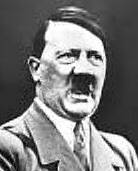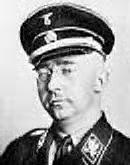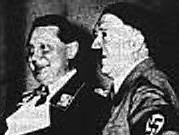
|
| Anti-Semitism Poster depicting Jews in a negative light stems
far back into history. Thus, Antisemitism facilitated the absorption of
racist ideas ill Europe and was the source and cornerstone of all ideology
that seemed to threaten all mankind. |
 Josef
Goebbels
Josef
Goebbels
|
| Minister of Propaganda, Josef Goebbels began hate campaing against
the Jews and other targeted ethnic groups. He had sole control over
what would be allowed to be printed or aired on the radio. The Nazis
were in complete control of the eyes, ears, and voice of Germany. |
 Adolf
Hitler
Adolf
Hitler
|
| Propaganda helped built the legend of Hitler's ascetic habits and selfless
devotion to Germany. Some of this legend of his patriotic image disappeared
when his long, secret association with Eva Braun was revealed. He married
her in April 1945, just before he committed suicide in the ruined Reichschancellery.
Hitler was declared dead officially Oct. 25, 1956, after his remains had
been definitely identified. |
 Eva
Braun
Eva
Braun
|
|
A Military State...armed and ready to shoot anyone who did not
adhere to the edicts of the Third Reich.
|
 SS Officer
One of the tactics used by the Military State was the ruthless treatment
of anyone who did not adhere to the policies of the Third Reich. The SS
Officers and their brutality were a nortorious part of Nazi Germany.
SS Officer
One of the tactics used by the Military State was the ruthless treatment
of anyone who did not adhere to the policies of the Third Reich. The SS
Officers and their brutality were a nortorious part of Nazi Germany. |
x
|
| Jews were segregated
from the rest of German society. They were distinguised from
the rest of society by the yellow star of David. They were persecuted
and the Jews were then sent to live in Ghettos. Jews were taken from
their homes, stripped of their personal posessions and forced to
live in crowded and filthy living conditions. |

|
| This is a picture from the Warsaw
Ghetto in Poland. The children were scaling the wall to sneak
food into the Ghetto. Living conditions inside the Ghetto were intolerable.
Starvation and disease were commonplace. Conditions were so extreme that
they participated in this activity despite the edict issued by Dr. Ludwig
Fischer. This edict imposed the death penalty on any
Jews who left the ghetto and also on anyone who helped them in any way. |

|
| Adolf Eichman was an SS Lieutenant-Colonel who was Chief of the Jewish
Office of the Gestapo during World War II. It was his department
that implemented the plan known as the
'Final Solution' which aimed at the extermination of all European Jews.
Eichmann's office was the headquarters for the implementation of the 'Final
Solution" |
 Heinrich
Himmler
Heinrich
Himmler
|
Himmler, Reichsfuhrer
-SS, head of the Gestapo and the Waffen-SS, and the Minister of the
Interior from 1943 to 1945 He was the organizer of the
mass murder of Jews in the Third Reich. From the outset of his career,
Himmler had introduced the idea of racial selection and special marriage
laws which would ensure coupling of people of 'high value' aryan qualities. |
|
| Head of the Party Chancellery and private secretary of the Fuhrer,
who by the end of World War II had become second only to Hitler himself
in terms of real political power, |
 |
| Commander-in-Chief of the Luftwaffe, President of the Reichstag, Prime
Minister of Prussia and, as Hitler's designated successor, the second
man in the Third Reich, |
|
1879 The term "anti-Semitism" was coined when Wm. Marr formed the Anti-Semitic
League to put political anti-Semitism into practice, to denote Jews as
a "race" apart from the Aryans. Denoted as a "race," there could be no
correction of the hated characteristics of the Jews, as there might be
if to be a Jew meant to be part of a religion, there being then the possibility
of conversion to Christianity.
1918 A "Jewish Order" was proposed in Germany, the order restricting the
rights and privileges of Jews in Germany, as well as their opportunities
for political and professional advancement. Hitler and the Nazi regime
later forged its Jewish Policy around these provisions.
1918 The Protocols of the Elders of Zion, composed by French anti-Semites
and distributed in Russia and Germany simultaneously, proposed that there
was an international Jewish organization and conspiracy, the plan of which
was to take over and rule the world. The document, which influenced people
world-wide, including many in the United states, charged that the tragedy
of World War I was the result of this world-wide conspiracy of Jews and
their hunger for power and destruction. Many hundreds of books, pamphlets,
newspaper and magazine articles spread the anti-Semitic argument around
the world.
1919 Rosa Luxemburg, Kurt Eisner, Gustav Landauer, socialists and revolutionists
in Germany who were murdered by counter-revolutionists because they were
Jews and believed to be part of the international conspiracy.
1919World War I ends officially with the signing of the Treaty of Versailles.
Germany is defeated. Germany is further humiliated by being forced to reduce
its army and to pay $57 trillion for damages. This ruins the German economy
and angers its citizens, many of whom, encouraged by their leaders, direct
their anger at the old scapegoat, the Jews.
1919Adolph Hitler begins attracting crowds with his fiery speeches. - 1920
The Nazis issue a 25-point program directed against the Jews.
1922 The German Foreign Minister, Walter Rathenau, of Jewish extraction,
was murdered by members of an anti-Semitic nationalist organization, who
admitted that they believed Rathenau belonged to a secret Jewish organization
planning to dominate the world.
1924 Adolph Hitler's Mein Kampf (My Struggle) was published, an autobiographical
account of his political development, in which he lays out his policy for
Germany, including his anti-Semitic doctrines, his clear denunciation of
the Jews, and his plans for solving the "Jewish Problem."
1932 The collapse of Germany's Weimar Republic. The Nazis become Germany's
largest political power.
1933 February 27, the Reichstag, or parliament, was dissolved.
1933The Reichstag building was burned.
1933Hitler calls for new elections.
1933The responsibility for the police transferred to Hitler's own people.
1933Hermann Goring appointed Commissar of the Prussian Police.
1933Josef Goebbels appointed Minister of Information and Propaganda.
1933 Heinrich Himmler laid the foundation of "SS State," by means of which
he would eventually extend his control throughout Germany and Europe.
1933Hitler withdraws from the League of Nations.
1933 March 23 The "Enabling Act" was passed, investing Chancellor Hitler
with full legislative authority. This act abolished the parliamentary regime
in Germany, passing the government entirely into the hands of the National
Socialists, Nazis.
1933Beginning in March, 50 concentration camps were opened in Germany,
later to number in the thousands.
1933Hitler and his party mounted their assault on the labor unions, the
Labor Party, the Social Democratic party. Hitler became absolute master
of Germany.
1933April 1 The Anti-Jewish Boycotts and Legislation put in place. The
restrictions specifically stated that protection was granted "all foreigners
without regard to their religion, origin, or race, and that the boycott
is... directed exclusively against the German Jews
1933 Hitler and the Nazis instituted three methods to achieve their objectives
of oppressing the Jews: terror, propaganda , and legislation.
1933The homes and offices of all Jewish professionals (doctors, lawyers,
teachers, professors, dentists, etc.) were marked with a special sign,
where SA guards began to be stationed. Many professionals were arrested
at their places of work, and such arrests were made throughout the country.
Jewish lawyers and judges were no longer permitted to work.
1933 April 11 Legislation was implemented defining who was a non-Aryan,
the official definition of who was a Jew.
1933 May 10 Goebbels organized public ceremonies at all the country's universities
for the burning of books by banned authors.
May 1935 The Nuremberg Laws formally established the separation of the
races and defined the rights of German citizens, excluding Jews from such
citizenship. After defining who is a Jew, the law forbade marriages between
Jews and "subjects of the state of Germany or related blood" and prohibited
sexual relations between these two peoples, punishable by death. No Jew
could be a citizen of the Reich, could vote on any political issue, or
hold office. All Germans must know the laws.
1936 Hitler's troops enter the demilitarized Ruhr region and the Rhineland,
violating the treaty previously held. When Britain and France did not intervene,
as they had said they would do, Mussolini of Italy, sensing Hitler's growing
power, drew closer to Hitler.
1936Hitler sends troops to fight on Franco's (the Spanish dictator) side
of the Spanish Civil War, beginning his intervention in the affairs of
Europe at large.
1938 Hitler institutes restrictive emigration policies for the Jews, making
it difficult, if not impossible, for them to leave the country. He was
abetted by the limited prospects of countries which would accept Jews,
most Western countries severely restricting their immigration policies
for Jews. In addition to restricting the immigration of Jews, Western countries
saw isolationism thrive in their lands, including the United States, and
a rise in animosity toward "foreigners."
1938 July 6 The Evian Conference of Western nations on Lake Geneva made
it clear that there was no haven in their countries for Jewish refugees
from Germany. Only the Dominican Republic accepted German Jews.
1938 September 29, 1938 The Nazis invade Czechoslovakia, with the acquiescence
of France and England.
1938 The annexation of Austria and the coming to full power of Adolph Eichmann
as the head of the SD (the Security Service) and one of the Nazis' major
mass murderers.
November 7, 1938 Hershel Grynspan -- in retaliation for the Polish Jews
residing in Germany having been driven by Germany across the border, in
sealed box cars, into Poland and then back again by Poland into a no-man's
land without food or shelter -- entered the German Embassy in Paris and
shot the third secretary, Ernst vom Rath.
November 9, 1938 Kristalnacht, "The Night of Broken Glass" The countrywide
pogrom against Jews, initiated by the SA (Storm Troopers) and the SD (Security
Service), in which Jewish shops (more than 7,500) across the country were
destroyed, 191 Synagogues were burned and more than 150 Synagogues otherwise
destroyed. The debris of the shattered shop windows gave the pogrom its
name. More than 30,000 Jews were arrested and incarcerated in Dachau, Buchenwald,
and Sachsenhausen, many hundreds of Jewish homes were looted and ruined,
and Jewish institutions were damaged, looted, and closed.
November 10, 1938 A similar pogrom took place in Vienna, where in that
city alone, 42 Synagogues were burned, some centuries old. Property in
Jewish apartments and businesses were confiscated, and 4,600 Jewish men
from all parts of Austria were sent to Dachau. 4,383 Jewish shops in Vienna
were closed, 1,950 Jewish apartments were forcibly vacated. In neither
country did any of the German or Austrian population intervene to save
the Jews or their property. Thousands of them helped with the looting and
with the smashing of shop windows. Very many moved into Jewish homes.
1938 saw the total destruction of the economic base for the Jewish population,
depriving them of any means of support or ability to defend themselves.
The result was the isolation of the Jewish population from any means of
assistance.
1939August 23, 1939 A non-aggression pact was signed between Germany and
the Soviet Union, establishing that if one of them should be the object
of military aggression by a third power, the other would not aid that third
power, and dividing Poland between the two powers, Germany to the West
and the Soviet Union to the east.
1939September, 1939 Germany invades Poland in what is called the Blitzkrieg
(lightning war).
1939September 17, 1939 Soviet forces crossed the Polish frontier in the
East and moved westward into the Polish heartland.
September 27, 1939 Warsaw, Poland's capital, falls.
December 19, 1939 Reinhard Heydrich established a special department in
charge of the special transfer of the masses of Jews for the purpose of
resettlement or elimination. Adolph Eichmann was charged with the evacuation
and deportation of the Jews. 10,000 to 15,000 people were deported out
of major centers each month. Concentration camps and ghettos are established,
where inhabitants lived and died under the worst imaginable conditions.
May 10, 1940 Winston Churchill became Prime Minister of England, and the
German armies began their Blitzkrieg against the countries of the West.
In 1940 the Vichy Government in France passes anti-Jewish laws.
1939-1941 Methods of deportation were perfected, the Jewish population
is completely displaced, forced labor is instituted, forced labor camps
are built, ghettos are enlarged, the Warsaw Ghetto continues to be beleaguered
and fights for life, as does the Lodz and other ghettos.
1941-1942 The Germans move East in an attempt to defeat the Soviets.
The Einsatzgruppen, the German killer squads move east to massacre Poles,
Russians and Jews, primarily Jews.
The first death-camps, extermination camps are set up, Chelmno, in Poland,
being the first in operation. •Holland, France, Belgium, Rumania, Hungary,
Yugoslavia, Slovakia are overrun by the Germans.
September 19-25, 1941 80,000 Jews are slaughtered by the Einsatzgruppen
in the Russian Ukraine, 34,000 of them in Kiev alone, where the Babi Yar
slaughter, one of the bloodiest and most notorious took place. Most of
the victims were the old, the sick, women, and children.
December 7, 1941 The United States enters the war after the attack by the
Japanese upon Pearl Harbor.
January 20, 1942 The Wannsee Conference, chaired by Heydrich, takes place
in the Berlin suburb of Wannsee. Here Heydrich stressed the need for "an
overall solution to the Jewish problem in Europe," and where he proposed
holding "joint discussions of all the relevant central agencies on the
other activities involved in this final solution." Heydrich, now in charge,
could harness ALL THE CIVILIAN AND ECONOMIC ADMINISTRATIONS OF GERMANY
AND THE OCCUPIED TERRITORIES FOR THE PURPOSE OF CARRYING OUT GERMANY'S
MISSION, THE DESTRUCTION OF THE JEWS.
1942 The death camps at Belzec, Sobibor, Treblinka, Maidanek, and Auschwitz-Birkenau
begin extermination operations.
Himmler orders the ghettos to be liquidated.
June 1942 The Ghetto at Cracow, site of Oscar Schindler's heroic rescue
of more than 1,000 Jews and of Schindler's
List, saw three separate selections of Jews, 5,000 of whom were sent
to Belzec.
Between July 22 and September 12, 1942, the unparalleled destruction of
the Warsaw Ghetto Jews took place, 350,000 of those Jews being transported
to death camps, primarily Treblinka.
October 1942 Six thousand more Cracow Jews are sent Belzec.
The ghettos throughout Poland are razed and their occupants sent to death
camps.
Deportations to death camps takes place in France, Holland, Belgium, and
Norway.
1943 Erntefest, the German word for "harvest festival" and Germany's name
for the destruction of the Jews, occurs almost simultaneously, upon Hitler's
orders, all over Europe: Greece, Yugoslavia, Italy, France, Belgium, Holland,
Poland, Slovakia, Bulgaria.
First armed resistance in the Warsaw Ghetto.
Danish Underground saves more than 7,000 Jews!
Revolt in Treblinka.
1944 - 1945 The last phase of the Final Solution; the Soviet armies approach
from the east, the Allied armies from the west; the death camps speed up
operations and are then evacuated; death marches from the camps to Germany
take place. Few prisoners survive.
In March, Hitler's armies invade Hungary.
Allied invasion of Normandy -- D-Day.
January 18, 1945 Auschwitz-Birkenau is evacuated, and the Russians "liberate"
the camp.
January to May, 1945 Other camps all over Europe are liberated by the allies,
the Soviets in the east, the Allies in the west. There were few survivors.
January 17, 1945 Raoul Wallenberg, savior of so many thousands of Jews
(estimated at 100,000), taken prisoner by the Soviets in Budapest, Hungary,
and never seen again.
May 8, 1945 Germany surrenders to the allies.
November: The Nuremberg War Crimes Tribunal commences. Holocaust and Resistance.
 The above link will take you to a wealth of information on the
Holocaust.
Click here to see a comparative timeline
U.S. and Nazi Germany
The above link will take you to a wealth of information on the
Holocaust.
Click here to see a comparative timeline
U.S. and Nazi Germany
|











